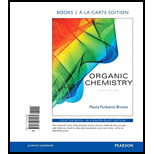
Concept explainers
(a)
Interpretation:
The curved arrow pattern should be drawn for the given reaction showing the movement of electrons for bond making and bond breaking.
Concept introduction:
Radical or free radical: unpaired valence electron of an atom, molecule, or ion is called as radical.
(b)
Interpretation:
The curved arrow pattern should be drawn for the given reaction showing the movement of electrons for bond making and bond breaking.
Concept introduction:
Radical or free radical: unpaired valence electron of an atom, molecule, or ion is called as radical.
(c)
Interpretation:
The curved arrow pattern should be drawn for the given reaction showing the movement of electrons for bond making and bond breaking.
Concept introduction:
Radical or free radical: unpaired valence electron of an atom, molecule, or ion is called as radical.
(d)
Interpretation:
The curved arrow pattern should be drawn for the given reaction showing the movement of electrons for bond making and bond breaking.
Concept introduction:
Radical or free radical: unpaired valence electron of an atom, molecule, or ion is called as radical.
Want to see the full answer?
Check out a sample textbook solution
Chapter 12 Solutions
Organic Chemistry, Books a la Carte Edition (8th Edition)
- - Draw Lewis structures for each of the following. Give the total number of valence electrons, select from the lists the number of Regions of Electron Density (REDs) around the central atom, the molecular shape, and the bond angles. - Do not put covalent bonds between metals and nonmetals. - Put brackets around anions to show both charge and quantity. Shapes tetrahedral pyramidal bent trigonal planar linear diatomic monatomic ions Bond Types nonpolar covalent polar covalent nonpolar & polar covalent ionic ionic & covalent Type of molecule Nonpolar Polar Ionic 5. C2Cl2 valence e-1 = shape= type of bonds = type of molecule = 6. AICI3 valence e-1 for one Cl-1 = shape= type of bonds = type of molecule = 7. K3PO3 valence e-1 = shape= type of bonds = type of molecule = 8. KH2PO3 valence e-1 = shape at the P= type of bonds = type of molecule = dicarbon dichloride aluminum chloride potassium phosphite potassium dihydrogen phosphitearrow_forwardWhat type of bond is formed?arrow_forwardDraw a Lewis dot structure Please include the number of valence electronsarrow_forward
- Explain the difference between a polar bond and a polar molecule.arrow_forwardPlace the bonds in order of increasing polar character. Place the bond with the least polar character at the top and the bond with the most polar character at the bottom.arrow_forwardExplain why acetic acid does not have any resonance structures while the acetate ion does ? How does this affect the bond order of these molecules ?arrow_forward
- Review Question 11.28 In a polar covalent bond, how do you determine which atom has a partial negative charge (5-) and which has a partial positive charge (8+)? The more electronegative atom in the bond between two atoms will more strongly attract electrons so it will have a partial charge because the charge. The less electronegative atom will have a partial bonding pair of electrons has been pulled away by the more electronegative atom.arrow_forwardUse Lewis theory to determine the formula for the compound that forms between each of the following pairs of elements. Ca and Te Express your answer as a chemical formula. Mg and Br Express your answer as a chemical formula. Na and S Express your answer as a chemical formula. In and O Express your answer as a chemical formula.arrow_forwarddraw the resonance structure of the molecule, and indicate the most stable form. Give the resonance hybrid at the endarrow_forward
- Draw the Lewis structures of the neutral atom and the ion of Carbon. Determine the number of electrons gained or lost in forming an ion.arrow_forwardA type of chemical bond that involves the transfer of one or more electrons between atoms of different types.arrow_forwardDispersion forces are produced when an electronegative atom pulls on the electron of a hydrogen atom so much that the proton of the hydrogen can closely interact with the electronegative atom of another molecule electronegative atoms pull electrons toward one area of the molecule, creating regions of partial positive and partial negative charge that are attracted to regions of other molecules with the opposite charge electrons are transferred from one atom to another to produce anions and cations that are then held together in a rigid lattice electrons in molecular compounds are constantly moving and produce short-term regions of positive and negative charge that are attracted to regions of other molecules with the opposite chargearrow_forward
 Organic Chemistry: A Guided InquiryChemistryISBN:9780618974122Author:Andrei StraumanisPublisher:Cengage Learning
Organic Chemistry: A Guided InquiryChemistryISBN:9780618974122Author:Andrei StraumanisPublisher:Cengage Learning General, Organic, and Biological ChemistryChemistryISBN:9781285853918Author:H. Stephen StokerPublisher:Cengage Learning
General, Organic, and Biological ChemistryChemistryISBN:9781285853918Author:H. Stephen StokerPublisher:Cengage Learning Organic And Biological ChemistryChemistryISBN:9781305081079Author:STOKER, H. Stephen (howard Stephen)Publisher:Cengage Learning,
Organic And Biological ChemistryChemistryISBN:9781305081079Author:STOKER, H. Stephen (howard Stephen)Publisher:Cengage Learning, Chemistry & Chemical ReactivityChemistryISBN:9781337399074Author:John C. Kotz, Paul M. Treichel, John Townsend, David TreichelPublisher:Cengage Learning
Chemistry & Chemical ReactivityChemistryISBN:9781337399074Author:John C. Kotz, Paul M. Treichel, John Townsend, David TreichelPublisher:Cengage Learning



